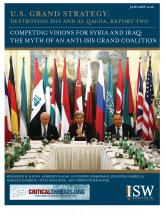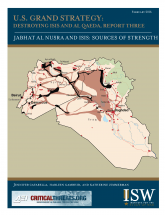Al Qaeda and ISIS: Existential Threats to the U.S. and Europe – Report 1
 The Institute for the Study of War (ISW) and the Critical Threats Project (CTP) at the American Enterprise Institute conducted an intensive multi-week exercise to frame, design, and evaluate potential courses of action that the United States could pursue to defeat the threat from the Islamic State in Iraq and al Sham (ISIS) and al Qaeda in Iraq and Syria. The planning group weighed the national security interests of the United States, its partners, its rivals, and its enemies operating in or influencing the conflicts in Iraq and Syria. It considered how current policies and interests are interacting in this complex environment. It identified the minimum endstates that would satisfy American national security requirements as well as the likely outcomes of current policies. The group also assessed the threat posed by al Qaeda and ISIS to the United States, both in the immediate and long term, and tested the probable outcomes of several potential courses of action that the United States could pursue in Iraq and Syria.
The Institute for the Study of War (ISW) and the Critical Threats Project (CTP) at the American Enterprise Institute conducted an intensive multi-week exercise to frame, design, and evaluate potential courses of action that the United States could pursue to defeat the threat from the Islamic State in Iraq and al Sham (ISIS) and al Qaeda in Iraq and Syria. The planning group weighed the national security interests of the United States, its partners, its rivals, and its enemies operating in or influencing the conflicts in Iraq and Syria. It considered how current policies and interests are interacting in this complex environment. It identified the minimum endstates that would satisfy American national security requirements as well as the likely outcomes of current policies. The group also assessed the threat posed by al Qaeda and ISIS to the United States, both in the immediate and long term, and tested the probable outcomes of several potential courses of action that the United States could pursue in Iraq and Syria.ISW and CTP will publish the findings of this exercise in multiple reports. This first report examines America’s global grand strategic objectives as they relate to the threat from ISIS and al Qaeda. It considers the nature of those enemy groups in depth and in their global context. The second report will define American strategic objectives in Iraq and Syria, along with those of Iran, Russia, Turkey, and Saudi Arabia, and will articulate the minimum required conditions of military-political resolutions to conflicts in Iraq and Syria. The final report will present the planning group’s evaluation of several courses of action.
The key findings of this first report are:
- Salafi-jihadi military organizations, particularly ISIS and al Qaeda, are the greatest threat to the security and values of American and European citizens. ISIS and al Qaeda pose an existential threat because they accelerate the collapse of world order, provoke domestic and global trends that endanger American values and way of life, and plan direct attacks against the U.S. and its partners.
- Syrian al Qaeda affiliate Jabhat al Nusra poses one of the most significant long-term threats of any Salafi-jihadi group. This al Qaeda affiliate has established an expansive network of partnerships with local oppositions groups that have grown either dependent on or fiercely loyal to the organization. Its defeat and destruction must be one of the highest priorities of any strategy to defend the United States and Europe from al Qaeda attacks.
- ISIS and al Qaeda are more than terrorist groups; they are insurgencies. They use terrorism as a tactic, but these organizations are insurgencies that aim first to overthrow all existing governments in the Muslim world and replace them with their own, and later, to attack the West from a position of power to spread their ideology to all of humanity. Separating the elements of ISIS and al Qaeda that are actively working to attack the West from the main bodies of those groups fighting in the Middle East, Africa, and South Asia is impossible. All al Qaeda groups and ISIS affiliates seek to take the war into the West to fulfill their grand strategic objective of establishing a global caliphate, albeit according to different timelines.
- Current counter-ISIS and –al Qaeda policies do not ensure the safety of the American people or the homeland. The primary objective of the U.S. government remains protecting the homeland and the American people, including safeguarding American values both in the homeland and abroad. The activities of ISIS and al Qaeda interact with the policies of Russia, Iran, and China to endanger the international systems upon which American safety and freedom depend. Any strategy to counter ISIS and al Qaeda will require coalition partners. However, there is no natural coalition of states with common goals that can readily work together to resolve this problem. The U.S. must lead its partners and ensure the continuation of existing guarantors of international security such as NATO.
- American and Western security requires the elimination of ISIS and al Qaeda regional bases and safe-havens. Salafi-jihadi groups independent of al Qaeda and ISIS form a base of support from which the enemy draws strength and resilience. ISIS and al Qaeda use the extensive safe haven and infrastructure of locally focused Salafi-jihadi groups to help plan, train, and equip fighters for attacks against the West. Destroying specific cells or nodes actively preparing attacks against the West is not sufficient. Al Qaeda and ISIS will be able to reconstitute the threat as long as Salafi-jihadi military organizations continue to support them.
PLANEX Pdf Report 1 —
Competing Visions for Syria and Iraq: The Myth of an Anti-ISIS Grand Coalition

The Institute for the Study of War (ISW) and the Critical Threats Project (CTP) at the American Enterprise Institute conducted an intensive multi-week planning exercise to frame, design, and evaluate potential courses of action that the United States could pursue to defeat the threat from the Islamic State in Iraq and al Sham (ISIS) and al Qaeda in Iraq and Syria. ISW and CTP will publish the findings of this exercise in multiple reports. The first report examined America’s global grand strategic objectives as they relate to the threat from ISIS and al Qaeda.[1] This second report defines American strategic objectives in Iraq and Syria, identify the minimum necessary conditions for ending the conflicts there, and compare U.S. objectives with those of Iran, Russia, Turkey, and Saudi Arabia in order to understand actual convergences and divergences. The differences mean that the U.S. cannot rely heavily on international partners to achieve its objectives. Subsequent reports will provide a detailed assessment of the situation on the ground in Syria and present the planning group’s evaluation of several courses of action.
The key findings of this second report are:
- The U.S. must accomplish four strategic objectives in Iraq and Syria to achieve vital national interests and secure its people: 1) destroy enemy groups; 2) end the communal, sectarian civil wars; 3) set conditions to prevent the reconstitution of enemy groups; and 4) extricate Iraq and Syria from regional and global conflicts.
- Any American strategy must take urgent measures to strengthen Iraqi Prime Minister Abadi and prepare contingency efforts for his fall. The collapse of the Abadi government and return of his predecessor Nuri al Maliki would be disastrous for the fight against ISIS.
- Ongoing international negotiations within the Vienna Framework are bypassing essential requirements for long-term success in Syria. Re-establishing a stable, unitary Syrian state that secures American interests requires the U.S. and its partners to 1) destroy ISIS, Jabhat al Nusra, and foreign Salafi-jihadi groups in Syria; 2) identify and strengthen interlocutors representing the Syrian opposition; 3) facilitate a negotiated settlement between the Syrian regime and opposition; 4) obtain regional acceptance of that settlement; 5) establish peace-enforcement mechanisms; and 6) reconstruct state institutions.
- The Salafi-jihadi militant base in Syria poses a threat to the U.S., but the U.S. must not simply attack it because that would put the U.S. at war with many Sunnis who must be incorporated into a future, post-Assad inclusive government. The U.S. must separate reconcilable from irreconcilable elements. These other Salafi-jihadi groups must meet the following conditions essential for core U.S. security objectives in order to participate: break with Jabhat al Nusra and ISIS; accept the principle of a future pluralistic and unitary Syrian state; reject violent jihad; commit to disarming to a policing and defensive level; and commit to the elimination of the current shari’a court system and the establishment of political institution-based governance.
- The superficial convergence of Iranian, Russian, Turkish, and Saudi strategic objectives with those of the U.S. on ISIS as a threat masks significant divergences that will undermine U.S. security requirements. Iran and Russia both seek to reduce and eliminate U.S. influence in the Middle East and are not pursuing strategies that will ultimately defeat al Qaeda and ISIS in Syria or Iraq. Turkey’s support for the Muslim Brotherhood and other Islamist groups, some linked to al Qaeda, stem from the ruling party’s intent to reestablish itself as an independent, Muslim, regional power. Finally, Saudi Arabia’s objectives remain shaped by perceived existential threats from Iran and a growing succession crisis, causing key divergences, especially over support to Salafi-jihadi groups. The U.S. must lead efforts to resolve the crisis in Syria and cannot outsource them to partners.
Jabhat al Nusra and ISIS: Sources of Strength – Report 3
The Institute for the Study of War (ISW) and the Critical Threats Project (CTP) at the American Enterprise Institute conducted an intensive multi-week planning exercise to frame, design, and evaluate potential courses of action that the United States could pursue to destroy the Islamic State in Iraq and al Sham (ISIS) and al Qaeda in Iraq and Syria. ISW and CTP are publishing the findings of this exercise in multiple reports in a series titled U.S Grand Strategy: Destroying ISIS and al Qaeda. The first report – Al Qaeda and ISIS: Existential Threats to the U.S. and Europe — described America’s global grand strategic objectives as they relate to the threat from ISIS and al Qaeda. The second – Competing Visions for Syria and Iraq: The Myth of an Anti-ISIS Grand Coalition — defined American strategic objectives in Iraq and Syria, identified the minimum necessary conditions for ending the conflicts there, and compared U.S. objectives with those of Iran, Russia, Turkey, and Saudi Arabia in order to understand actual convergences and divergences. This third report assesses the strengths and vulnerabilities of ISIS and al Qaeda affiliate Jabhat al Nusra to serve as the basis for developing a robust and comprehensive strategy to destroy them. Subsequent reports will provide a detailed assessment of the situation on the ground in Syria and present the planning group’s evaluation of several courses of action.
The key findings of this third report are:
- ISIS and al Qaeda are Salafi-jihadi military organizations with distinct sources of strength. The groups interact differently with the populations among which they operate. These differences create distinct requirements for destroying each organization.
- U.S. strategy must operate against both ISIS and Jabhat al Nusra simultaneously. Attacking the source of ISIS’s strength—its territorial caliphate—is relatively straightforward to describe. Expelling ISIS’s hybrid forces from terrain and setting conditions to prevent their return is a much more complicated task with which American and Western militaries are nevertheless familiar. Jabhat al Nusra, however, is primed to benefit from ISIS’s defeat by moving into territories from which ISIS has been cleared. Current efforts that focus on ISIS first and plan to address Jabhat al Nusra second (if at all) have a high probability of facilitating Jabhat al Nusra’s expansion.
- Current U.S. policy appears to assume that depriving ISIS of its control of Mosul or ar Raqqa will lead to the organization’s collapse. That assumption was likely valid in 2014 and early 2015, but it is no longer true. ISIS has established itself in multiple major urban centers, including Fallujah, Palmyra, and Deir ez Zour. Any of these cities in Iraq or Syria could serve as a de-facto capital for its caliphate were it deprived of Mosul and ar Raqqa. ISIS must be driven from all urban and major rural population centers in Iraq and Syria if it is to be destroyed.
- Jabhat al Nusra draws strength from its intertwinement with Syrian Sunni opposition groups. The slow pace of U.S. strategy and its exclusive prioritization of ISIS are facilitating Jabhat al Nusra’s deeper entrenchment within the opposition. It is not possible to attack this intertwinement directly, and even most indirect efforts will likely be counter-productive. Identifying means of separating Jabhat al Nusra from the opposition in order to destroy it is the most difficult intellectual task in developing a strategy for Syria, and the one on which the planning group is continuing to focus.
- All operations against Jabhat al Nusra and ISIS must be integrated into a single coherent strategic concept that takes account of the divergence of interests between the U.S. and its European partners, on the one hand, and Russia, Iran, Turkey and Saudi Arabia on the other. As the recent Russian-Iranian-regime envelopment of Aleppo shows, Moscow and Tehran are pursuing objectives antithetical to American interests and their operations will further radicalize the conflict in ways that entrench ISIS and al Qaeda.
- The U.S. and its Western partners will have to conduct multiple simultaneous and successive operations whose exact course cannot be described fully in advance. The initial operations must focus on altering the conditions on the ground in order to expose Jabhat al Nusra’s sources of strength to attack. They must alter the popular narrative that the West has abandoned the Syrian Sunni Arabs in favor of Iran, Assad, and Russia. This task will be impossible as long as the West offers the Sunni no meaningful support in the face of the Assad regime’s imminent threat to their survival as individuals and communities.

